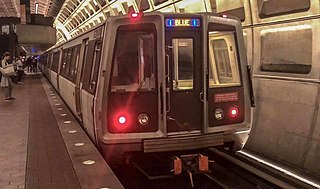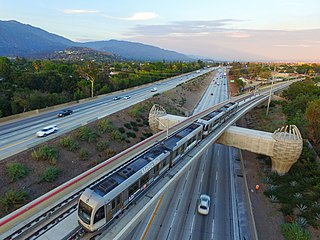
The Blue Line is a rapid transit line of the Washington Metro system, consisting of 28 stations in Fairfax County, Alexandria and Arlington, Virginia; Washington, D.C.; and Prince George's County, Maryland, United States. The Blue Line runs from Franconia–Springfield to Downtown Largo. The line shares track with the Orange Line for 13 stations, the Silver Line for 18, and the Yellow Line for 7. Only 3 stations are exclusive to the Blue Line.

The Orange Line is a rapid transit line of the Washington Metro system, consisting of 26 stations in Fairfax County and Arlington, Virginia; the District of Columbia; and Prince George's County, Maryland, United States. The Orange Line runs from Vienna in Virginia to New Carrollton in Maryland. Half of the line's stations are shared with the Blue Line and over two thirds are shared with the Silver Line. Orange Line service began on November 20, 1978.

The Silver Line is a system of bus routes in Boston and Chelsea, Massachusetts, operated by the Massachusetts Bay Transportation Authority (MBTA). It is operated as part of the MBTA bus system, but branded as bus rapid transit (BRT) as part of the MBTA subway system. Six routes are operated as part of two disconnected corridors. As of 2019, weekday ridership on the Silver Line was 39,000.

Union Station, also known as Pennsylvania Station and commonly called Penn Station, is a historic train station in Downtown Pittsburgh, Pennsylvania. It was one of several passenger rail stations that served Pittsburgh during the 20th century; others included the Pittsburgh & Lake Erie Railroad Station, the Baltimore and Ohio Station, and Wabash Pittsburgh Terminal, and it is the only surviving station in active use.

The A Line is a 48.5-mile (78.1 km) light rail line in Los Angeles County, California. The A Line runs east-west between Azusa and Pasadena, then north-south between Pasadena and Long Beach, via Downtown Los Angeles. The A Line is currently the longest light rail line in the world.

Pittsburgh Regional Transit is the second-largest public transit agency in Pennsylvania and the 20th-largest in the United States. The state-funded agency is based in Pittsburgh and is overseen by a CEO and a board of unpaid volunteer directors, some of whom are appointed by the county executive and approved by the county council; and one each by the majority and minority leaders by each political party. After operating as the Port Authority of Allegheny County for most of its history, the agency rebranded under its current name in June 2022. In 2022, the system had a ridership of 35,976,700.

Allentown is a neighborhood located in the southern portion of the city of Pittsburgh, Allegheny County, Pennsylvania. The ZIP code used by residents is 15210, and has representation on the Pittsburgh City Council by the council member for District 3.

The Panhandle Bridge carries the three lines of the Port Authority Light Rail Network across the Monongahela River in Pittsburgh, Pennsylvania. The name comes from Pennsylvania Railroad subsidiary Pittsburgh, Cincinnati, Chicago and St. Louis Railroad, also known as the Panhandle Route, which operated over the bridge.

Pittsburgh Railways was one of the predecessors of Pittsburgh Regional Transit. It had 666 PCC cars, the third largest fleet in North America. It had 68 streetcar routes, of which only three are used by the Port Authority as light rail routes. With the Port Authority's Transit Development Plan, many route names will be changed to its original, such as the 41D Brookline becoming the 39 Brookline. Many of the streetcar routes have been remembered in the route names of many Port Authority buses.

Transportation in Pittsburgh, Pennsylvania is different than in many other major American cities. A large metropolitan area that is surrounded by rivers and hills, Pittsburgh has an infrastructure system that has been built out over the years to include roads, tunnels, bridges, railroads, inclines, bike paths, and stairways; however, the hills and rivers still form many barriers to transportation within the city.

The Pittsburgh Light Rail is a 26.2-mile (42.2 km) light rail system in Pittsburgh, Pennsylvania, and surrounding suburbs. It operates as a deep-level subway in Downtown Pittsburgh, but runs mostly at-grade in the suburbs south of the city. The system is largely linear in a north-south direction, with one terminus near Pittsburgh's central business district and two termini in the South Hills. The system is owned and operated by Pittsburgh Regional Transit. The T is one of the surviving first-generation streetcar systems in North America, with the oldest portions of the network dating back to 1903 and the Pittsburgh Railways. It is also one of only three light rail systems in the United States that continues to use the broad 5 ft 2+1⁄2 in Pennsylvania Trolley Gauge on its lines instead of the 4 ft 8+1⁄2 instandard gauge. In 2022, the system had a ridership of 2,429,500.

The Red Line is a line on the Pittsburgh Light Rail system that runs between South Hills Village and Downtown Pittsburgh via the Beechview neighborhood. The companion route, the Blue Line, branches off north of Martin Villa – which closed in 2012 – and runs through Overbrook. In March 2007, the closure of the Palm Garden Bridge for refurbishment suspended the Red Line for five months; it resumed service in September.

Station Square station is an intermodal transit station in the South Shore neighborhood of Pittsburgh, Pennsylvania, located at the Station Square shopping and entertainment complex. It is served by the Red Line, Blue Line, and Silver Line of the Pittsburgh Light Rail network, and is the northern terminus of the South Busway. The station is near the Monongahela Incline and the Gateway Clipper Fleet.

The Martin Luther King Jr. East Busway is a two-lane bus-only highway serving the city of Pittsburgh and many of its eastern neighborhoods and suburbs. It was named after Martin Luther King Jr. in recognition of the eastern portion of the route's serving many predominantly African-American neighborhoods, such as Wilkinsburg and East Liberty. It is owned and maintained by Pittsburgh Regional Transit.

The South Busway is a two-lane bus rapid transit highway serving southern portions of the city of Pittsburgh. The busway runs for 4.3 miles (6.9 km) from the Mt. Washington Transit Tunnel across the Monongahela River from Downtown Pittsburgh to the Overbrook neighborhood of the city, bypassing the crowded Pennsylvania Route 51. It is owned and maintained by Pittsburgh Regional Transit, the public transit provider for Allegheny County and the Pittsburgh region.

The PATrain, also known as Mon Valley Commuter Rail, was a commuter rail service owned by the Port Authority of Allegheny County in the Monongahela Valley in the US state of Pennsylvania. Service began in 1975 when the Port Authority assumed ownership of the Pittsburgh–McKeesport–Versailles commuter trains operated by the Baltimore and Ohio Railroad (B&O) with the support of PennDOT. The Port Authority discontinued the service in 1989.

The Blue Line is a Pittsburgh Light Rail line that runs between Downtown Pittsburgh via the Overbrook neighborhood to South Hills Village.

The Mon Line is an 85-mile long Norfolk Southern rail line which runs along the Monongahela River for most of its route.

The Silver Line is a line on the Pittsburgh Light Rail system that runs between Downtown Pittsburgh through the Overbrook neighborhood to Library. It is the renamed service for the former Blue Line –Library branch.





















